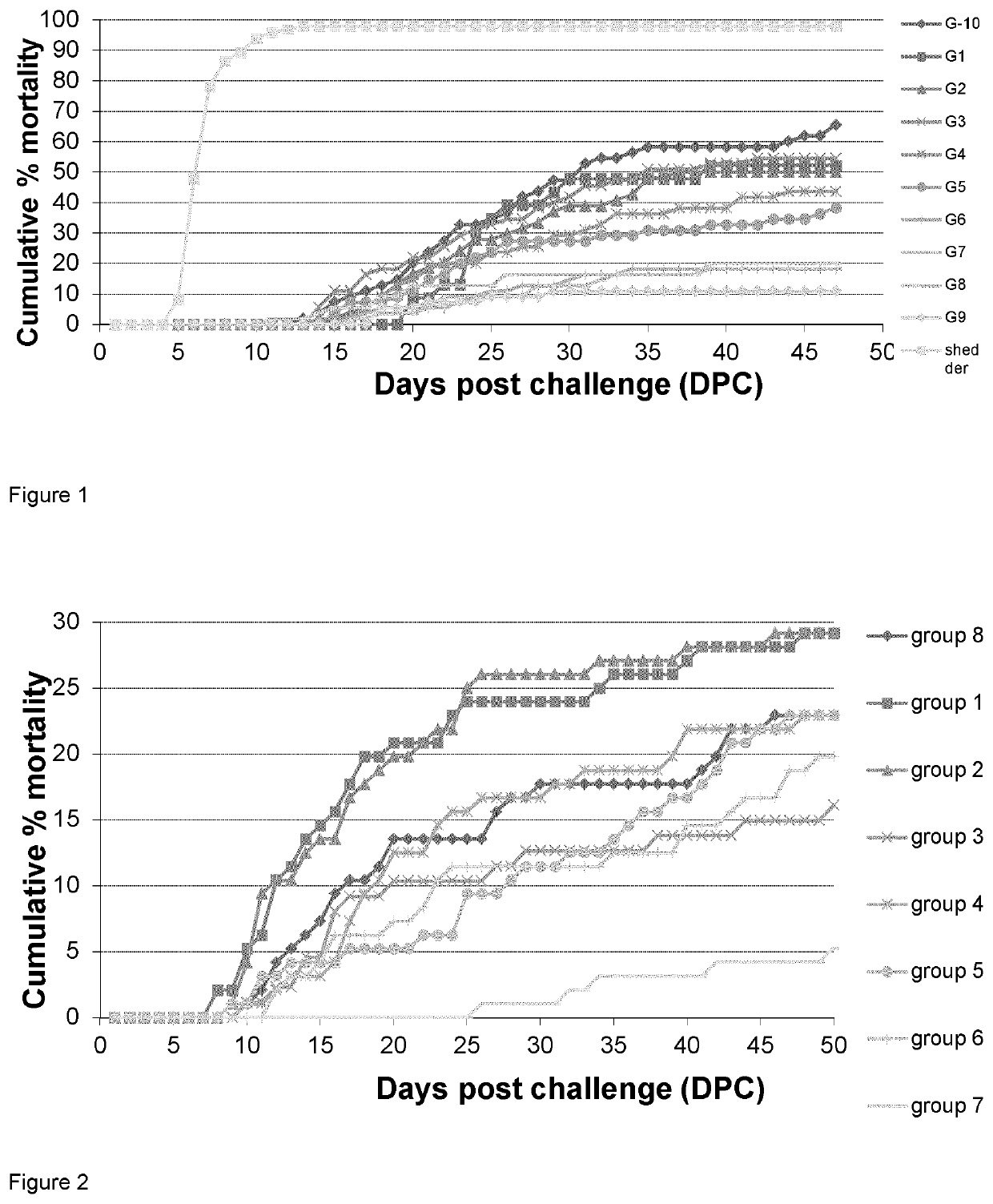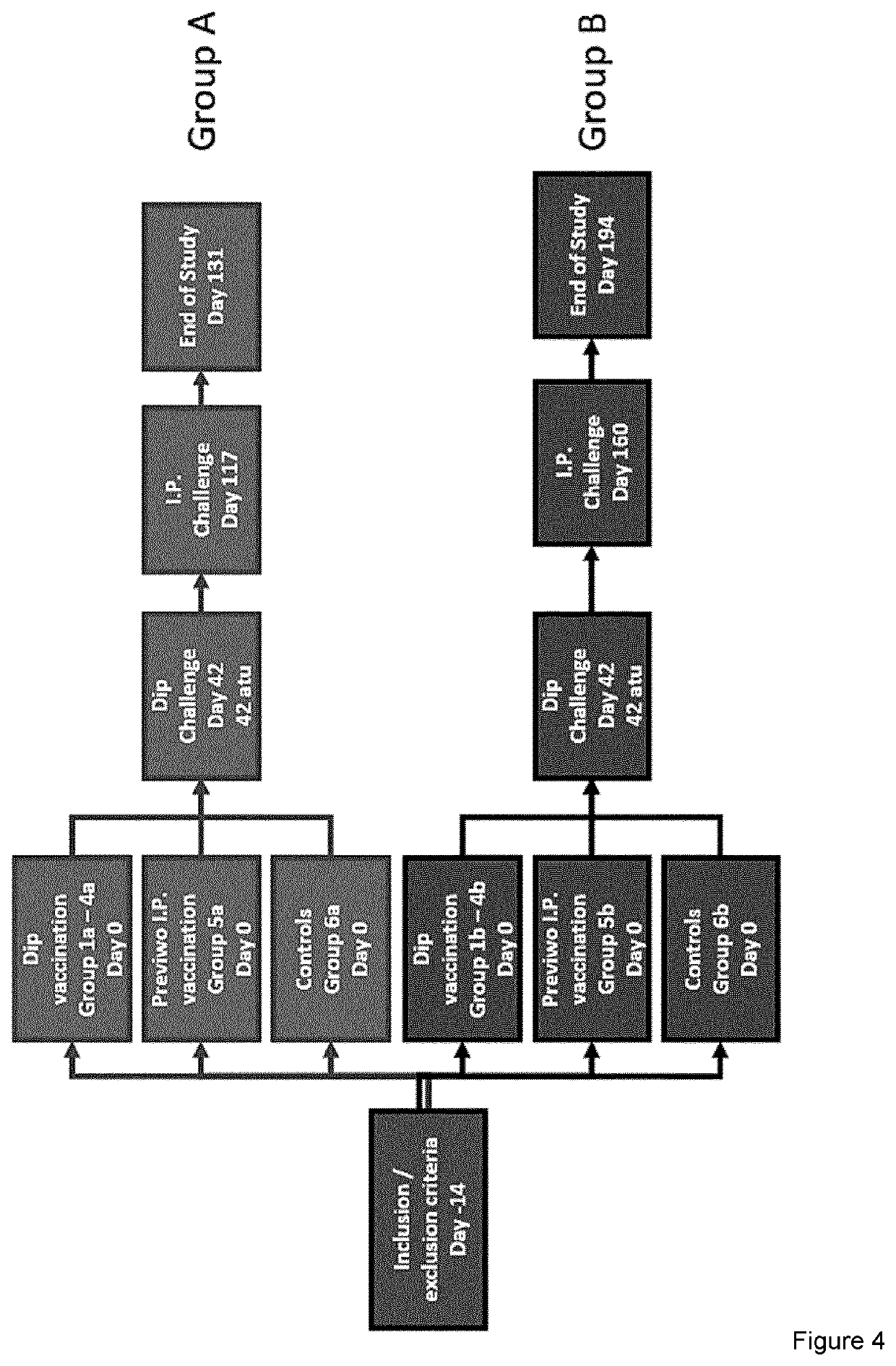Bacterial vaccine
- Summary
- Abstract
- Description
- Claims
- Application Information
AI Technical Summary
Benefits of technology
Problems solved by technology
Method used
Image
Examples
example 1
[0181]Fresh bacterial cells were taken from enrichment plates (ex. blood plates) and used for the inoculations in the different media.
Preparation of Cultures A, B, C, and D:
[0182]Tubes with following contents, 500 μl in each tube, were prepared:
[0183]a—Physiological saline water, e.g. 0.9% NaCl
[0184]b—Leibowitz medium (cell culture media)
[0185]c—Blood serum from horses
[0186]Bacterial cells were taken from blood plates (with 2.5% additional NaCl for the marine fish pathogenic bacteria and mixed well into the tubes. Pre-cultures a., b. and c. were allowed to incubate for 1 to 2 hours at the body temperature relevant for the bacteria when causing disease, i.e. 10° C. for Atlantic salmon and 37° C. for S. pseudintermedius from dogs. Then 250 μl from each of tubes a-c were transferred as follows:
[0187]From a: 250 μl to tube A: 1000 μl LB (Luria broth) with 0.9% NaCl
[0188]From a: 250 μl to tube B: 1000 μl Leibowitz
[0189]From b: 250 μl to tube C: 1000 μl gelatin 3.2% ...
example 2
on of Farmed Atlantic Salmon Against Furunculosis
[0210]Furunculosis caused by Aeromonas salmonicida ss salmonicida, a Gram-negative salmonid pathogen is one the major threats against farming of Atlantic salmon. In 1985 furunculosis was imported from Scotland to mid-Norway with Atlantic salmon smolts. A high level of antibiotics in medicated feed was established in the attempt of controlling the disease that spread along the Norwegian coast. The vaccines available did not protect efficient against A. salmonicida ss salmonicida. The fast development of antibiotic resistance against tetracyclines, sulphonamides, trimethoprim and quinolones made the use of antibiotics inefficient before the addition of mineral oil in the adjuvant of the vaccines was tested in the mid-1990's. The mineral oil as adjuvant resulted in 80 to 90% protection. However, a side-effect from the use of mineral oil in the form of inflammation with secondary adhesions between the peritoneum and the organs of the abdo...
example 4
Details of Example 4
[0391]Two cohorts of salmon—A and B—with 6 groups in each cohort were vaccinated with 4 different dip vaccines, one i.p. vaccine made with the novel vaccine preparation protocol and one group in each cohort were unvaccinated controls. After an immunization period of 42 days cohort A was bath challenged with the ulcerative strains M. viscosa and Aliivibrio wodanis strains (FIG. 4).
[0392]Winter ulcer a recurrent problem to the aquaculture industry in Scotland, Iceland, Faroe Islands, Ireland, Canada, Maine in USA and Norway.
[0393]Immersion vaccines have been used with success for classical bacterial infections such as Vibrio spp and Yersina ruckeri, and provide a good protection within a period of six months and are typically used to vaccinate small fish of 1-5 grams. This gives relatively good protection (50-60% RPS) until they are big enough to receive an injection vaccination.
[0394]One of the limitations of immersion vaccination are that the immunity does not la...
PUM
| Property | Measurement | Unit |
|---|---|---|
| Fraction | aaaaa | aaaaa |
| Fraction | aaaaa | aaaaa |
| Fraction | aaaaa | aaaaa |
Abstract
Description
Claims
Application Information
 Login to View More
Login to View More - R&D
- Intellectual Property
- Life Sciences
- Materials
- Tech Scout
- Unparalleled Data Quality
- Higher Quality Content
- 60% Fewer Hallucinations
Browse by: Latest US Patents, China's latest patents, Technical Efficacy Thesaurus, Application Domain, Technology Topic, Popular Technical Reports.
© 2025 PatSnap. All rights reserved.Legal|Privacy policy|Modern Slavery Act Transparency Statement|Sitemap|About US| Contact US: help@patsnap.com



